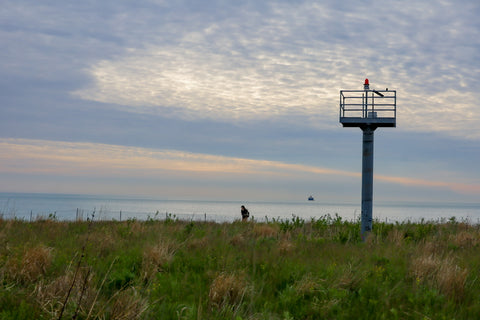The Montrose Beach Dunes Natural Area is one of the hidden gems within Downtown Chicago. Located on the eastern end of Montrose Beach in Lincoln Park, this state natural area protects a globally rare panne habitat consisting of a beach, wetland, fore dune, and a bird sanctuary home to 300+ species of migratory birds. This site has had a long history of uses from starting out as a landfill, becoming a secret missile instillation during the Cold War, and finally allowed to be revitalized through grassroots and state funded initiatives. Today, this is one of the best spots in the whole city for bird watching, nature photography, and for anyone looking to escape the confines of the city by taking a stroll along its 2 mile trail system.
Montrose Beach Dunes Natural Area | Google Maps
Having grown up in Chicago, Montrose Beach was one of a dozen places we would spend our summers swimming along the vast lakefront stretching the entire length of the city. Back then, this area was nothing more than a stretch of rolling lawn with a few hedges, solitary trees, and an overwhelming amount of litter. A lot has changed in those twenty years and thankfully for the better.

On a recent trip to my hometown, I made it a point to visit this hidden gem and experience one of the most unique places in the whole city that most people don’t even know exists. I arrived shortly after dawn to not just take advantage of all the wildlife viewing opportunities, but to avoid paying a parking meter as its free to park here before 8 a.m.

Walking in through the main entrance off Montrose Harbor Drive, one quickly forgets that they’re in one of the largest metropolis in the country and quickly become immersed in the sights and sounds of a wild place. The mulch trail leads through a heavily wooded area that surrounds the bird sanctuary almost like an outer wall. Once inside, you step into a vast meadow that seems to go on forever, defying all sense of depth and space.

Over three hundred species of migratory birds call this place home and they’re all out and about this morning. Warblers, thrushes, geese by the dozen, I could go on and on. Of all the places I’ve visited, I have never seen such a dense concentration of birds and small mammals tucked into one square foot of space before.

Its crazy to think that this entire place rests on a former landfill that was created out of a section of coastline dredged to build a harbor for Lincoln Park back in the 1920’s. The city hired famed landscape architect Alfred Caldwell to design a natural looking landscape of gently rolling hills and expansive meadows that would become an extension of the larger park. With the onset of WWII, the United States Army took over what was then known as Montrose Point and built a radar station in the center of its grassy knoll. During the height of the Cold War, the site was further developed into a full on Nike Missile Base, capable of defending the city from an air raid.

During this period of time, the Army planted a dense hedgerow of Japanese honeysuckle to disguise the barracks from suspecting onlookers. As the nationwide defense system known as ARADCOM, was scaled back and Montrose Point was decommissioned, that original hedgerow would become the catalyst for the future bird sanctuary and natural area.

Long after the barracks were torn down and the missile silos filled in, residents began to notice the abundance of migratory birds that would flock to this hedge during their spring and fall migrations. It quickly garnered the attention of nature enthusiasts and with the help of local naturalists, this little piece of land was officially designated a protected bird sanctuary in 1991. To this day, the total area protected has been expanded to nearly 13 acres.

Following the maze like trails that cut through dense plantings of ironweed and big bluestem almost as tall as me, I headed down a path towards the sound of the crashing waves. With nothing but a stretch of blue ahead of me, I broke through the woodland and emerged onto the grassy dunes overlooking Montrose Harbor. The views here are so unbelievable they look like a scene from a postcard. While some of this has in fact been manufactured at first, what you see at this point is a sort of planned chaos.

In 2001, the Chicago Park District stopped grooming the area all together in order to encourage the natural formation of sand dunes. Throughout the last twenty years, the site has been transformed into something closer to its original state before human interference. As a result, Montrose Beach Dunes is now made up of beach, foredune, and a globally rare panne habitat which supports numerous regionally threatened and endangered species. A panne is an interdunal wetland that occurs anywhere there is a large coastal perched dune, or where narrow swales occur behind water. These natural areas are quickly disappearing due to the over grooming and development of the shores surrounding the Great Lakes.

As a sign that the conservation efforts of this area are heading in the right direction, it has recently become a nesting ground for the federally endangered Great Lakes Pipping Glover. The shores of the Great Lakes were once home to nearly 800 pairs of these native birds. In 1990 that number had dropped all the way to 13. Their numbers are slowly rebounding and there are now 65-70 nesting pairs in the Great Lakes Region, with a few calling the dunes at Montrose Beach home. Walking along the dunes trail north towards the lake, the path heads down from the dunes into the wetland panne habitat that earned this place its state protection.

Here, water from the protected beach crashes over the sand dunes closest to shore during high tide, leaving isolated pools of water to create a series grassy marshes. These tidal marshes dry and fill back up completely throughout the changing tides and seasons. On this early morning ring billed gulls and greater yellow legs were out sun bathing on the beach alongside ducks diving underwater for a snack. The concrete water break that juts out into Lake Michigan is now a pedestrian path that leads all the way to the Montrose Beach Beacon. Taking a stroll along its length, you get a magnificent view of the dunes natural area, with the city skyline right behind it. Looking out to my right is an open sea of water stretching out past the horizon.

Off in the distance, its easy to make out a small structure floating over the lakes surface way out there that looks like an oil rig. It would shock most people to know that those tall cylinder structures, called water cribs, used to collect and house some of the city fresh drinking water. The nine offshore cribs would collect water and transport it through tunnels located close to 200 feet beneath the lake, leading to pumping station onshore, and then to purification plants. Till this day water from these cribs supplied the entire city and its 118 suburbs with all of its drinking water.

Its easy to lose track of time while visiting this unique place. There is so much going one as you travel from one type of ecosystem to the other, watching the birds going about their daily lives and then switching your gaze to people watching between. As much time as I spend in far away isolated wilderness areas, had you dropped me off in the middle of Montrose Beach Dunes and not told me I was in the heart of Chicago, I would have thought I was somewhere out in a rural backcountry park.

Next up, I'll be traveling to southeastern Kentucky to re-visit the Big South Fork National River & Recreation Area. Here, hidden deep within the forested cliffs high above the Big South Fork of the Cumberland River is the states tallest waterfall Yahoo Falls. Venturing past the falls, a 1.8 mile trail leads to one of the largest and most interesting arches in the area, Yahoo Arch. Stay tuned for our upcoming adventures and until next time, see y'all on the trails!









0 comments